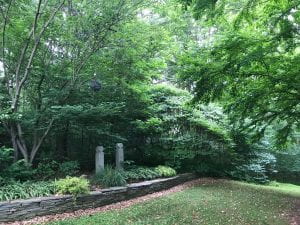A major summertime gardening task is controlling weeds. Especially this year, with all the rain we’ve had, weeds are running rampant in many gardens.
The best way to control weeds in the garden is to prevent them from growing in the first place. Planting desirable plants close together to cover the ground is the most natural and effective method of weed control. Some people seem to think vast spaces of mulch are beautiful, but ideally mulch is a temporary ground cover until plants fill in. That said, mulch spread to a thickness of one to three inches will prevent many annual weeds from germinating. So, mulch is better than bare soil. Anyone who has managed a vegetable garden knows that bare soil will become a bed of weed seedlings in a few weeks with sufficient rain. Keep mulch away from tree trunks, where is will rot the bark and open wounds for disease and insect entry. And don’t let the mulch get thicker than about 3 inches. We want plant roots to grow in the soil, not the mulch.
Another method of preventing weeds is to use a preemergent herbicide. Crabgrass is controlled in the lawn with a preemergent in early to mid-spring. Unfortunately, in a rainy year it may be necessary to reapply crabgrass preemergents to keep the herbicide barrier in tact and prevent weed seedlings from emerging. Summer annuals can also be controlled in landscape beds with the use of a preemergent herbicide, but it must be applied before the weeds come up. I have effectively controlled Japanese stilt grass in some areas of my landscape by applying a preemergent in early spring.
Finally, weed fabric. black plastic or even newspaper can be used in the vegetable garden to either smother or prevent weed emergence. We have a large vegetable garden created by the former land owners and since we can’t use all the space, rotate areas to cover with black plastic for a season. We let leaves and weeds decompose and usually have great soil for the following year as we rotate planting areas. We have also learned it is well worth the time to plant tomatoes and peppers in rows and use weed fabric in between. There are fewer weeds and a good surface for walking on to pick your produce. This year we seeded corn, beans and other veggies in rows spaced perfectly to allow us to put down weed fabric once the crops germinated. When putting weed control in an area where you are growing plants, you must use a permeable fabric, not black plastic, so water gets to the plant roots.
We already know “on ounce of prevention is worth a pound of cure” (Benjamin Franklin), but if you have weeds already growing in your garden, prevention is not an option. There is a school of thought that says it is better to spot treat with an herbicide than to disturb the soil by pulling up the weed. That makes sense when you think about how many weed seeds are present in soil (130 million weed seeds in a plow acre in a Minnesota study). When you pull up a deep-rooted weed, you disturb the soil, bringing new weed seeds to the surface. By spot treating with an herbicide, no additional weed seeds are exposed.
Another school of thought believes in regular tillage when weeds are young to desiccate those weed seedlings. I admit, it is a lot easier to pull weeds as you see them than to mix up herbicides whenever you want to attack your weeds. Probably for most people, a combination approach makes sense. Be sure when you pull weeds to use a trowel and get the entire root. Another strategy is to use a flame torch to control weeds. We had to buy a torch to seal some roofing material, so we started experimenting with it in the vegetable garden. It burns off the weed tops but does not kill the roots. Although with young plants and repeated use, it does a pretty good job. Be careful not to burn desirable plants. This method is best used for cleaning up larger spaces in a vegetable garden prior to seeding.
When you spot spray for weeds in the garden, be sure to spray on a calm day and use a spray nozzle that allows you to carefully direct the herbicide to the weeds you are targeting and avoid desirable plants. There has been much written about glyphosate (sold by Monsanto as RoundUp) in the news lately. I suggest you consider the source of the information you are evaluating. Many people believe that since two juries have found RoundUp at fault in causing the plaintiff’s cancer, it must be a cancer-causing chemical. Everyone has the right to make their own decision, but for my money, I will believe the data from over 100 research studies that support the belief that RoundUp does not cause cancer, before I will believe 24 jurors, most of whom are probably not scientists, who were convinced by a lawyer (also not a scientist) that RoundUp does cause cancer. What I can tell you for sure, is to avoid “home remedies” for weed control. There are many substances we have in our kitchen or bathroom cabinets that are toxic to humans and bad for the environment. Do not mix up your own brew to control weeds, no matter what you read on the internet!


